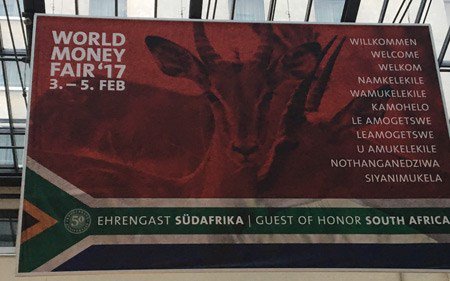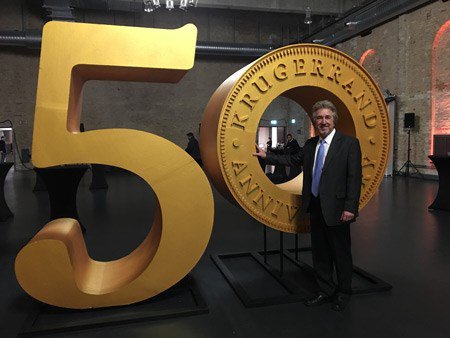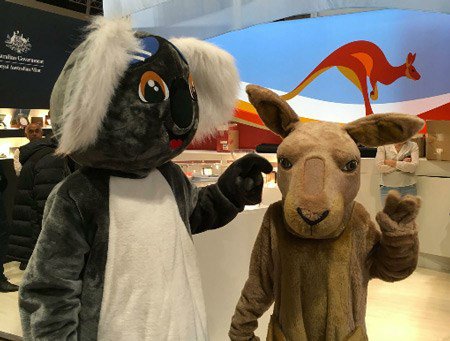Attending the World Money Fair in Germany is a rewarding experience
By Jeff Garrett for Numismatic Guaranty Corporation (NGC) ……
During the previous week I attended the World Money Fair in Berlin, Germany. Over the years I’d heard a lot about this convention but had never been able to attend. My main specialty has always been United States coinage and I doubted there would much to interest me at a European coin show. That has changed in recent years as my interests have grown to include ancient coinage. Also, as President of the American Numismatic Association (ANA), I wanted to find out why this show is so successful and look for ideas to improve our own World’s Fair of Money. The World Money Fair is extremely successful, and I wanted to find out why.

All photos courtesy Jeff Garrett & NGC
From the start I could tell that Europeans operate quite differently than rare coin operations in the United States. The show is held at the largest hotel in Germany. The Estrel Hotel and Convention Center is gigantic, with over 1,000 rooms. I had not booked my room in time and they were sold out. It should be remembered that this show includes representation from every facet of numismatics. This means rare coin dealers, auction houses, mass-market companies, world mints, packaging companies, coin supplies dealers, bullion companies, mint equipment companies (some with full scale presses on the bourse floor) and many others. The diversity is astounding.
Europeans love meetings, and this was obvious as soon as you entered the hotel. There were rows of tables in the lobby with people giving pitches on their wares. Nearly every meeting room in the hotel was booked by some large company and they were conducting non-stop meetings the entire week. A couple of my friends who do extensive business with these companies told me they had 30 to 40 meetings lined up for the week. Most of the meetings had been planned for months. The show did not start until Friday and there was a constant buzz of activity in the lobby from Monday on.

Later in the week the crowds started to assemble for opening ceremonies. The hotel was jam-packed with the lines going out the door of the convention hotel. I have not heard the final attendance number, but they had estimated 10-15,000 people for the week. This is more than our own ANA World’s Fair of Money. For anyone worried about the demand for rare coins and paper money, you can take heart in the crowds these events generate. There were thousands of people eager to buy everything from ancient coins to the most recent offerings from mints around the world. The South African Mint was especially active this year as they were celebrating the 50th anniversary of the Krugerrand. Their banners and marketing material were everywhere and hard to miss.
The week also featured two invitation-only educational forums.
The first was the Technical Forum, with minting experts from all ranges of the coining process explaining or announcing recent innovations. This was a little too technical for my taste, but the other two hundred or so people seemed to be enthralled by the presentations.
The second day’s event was the Media Forum that was intended for the introduction of new numismatic products. The South African Mint was first up with an impressive audio and visual presentation announcing the products produced to celebrate the 50th Anniversary of the Krugerrand. On Saturday, Krause Publications announced the winner of their “Coin of the Year” (COTY) award. Modern coins are an extremely important facet of this convention.
Another interesting aspect of the show was the prevalence of companies that sell gold and silver. Bullion is a big deal at these shows and it was available in every shape and size imaginable. The South African Mint was selling a variety of its venerable gold Krugerrand in sizes of 1/50 (yes, it’s super tiny), 1/10, 1/4, 1/2, 1, 5 and 50 ounces ($150,000, if you’re curious). They were also offering a silver and platinum Krugerrand for the first time and were sold out on the first day with the stock they had brought to the show. Europeans love bullion and its long-term safety from currency depreciation. I imagine that people who still remember the World Wars and political instability have a deeper appreciation for bullion than most Americans.

The show also has an amazing diversity of booth operations. There was a section of small tables of just a few feet, to major installations that surely cost six figures. The largest booths were done by the world mints and they have the most dominant presence at the conventions. Several large mass market companies also erected elaborate booths with eye catching graphics. Many of these companies were major sponsors of the various events and banquets. Most evenings some world mint or mass-market company was hosting a reception. They know how to entertain at the World Money Fair!
I have heard for years that European collectors did not care for third-party certified coins. This must be changing as evidenced by the large number of tables with certified coins being offered. Nearly every large numismatic company offered some NGC coins at their booths. Ancient coins were particularly popular and world coins seemed to be gaining steam as well. The reasons for third-party grading are universal in my opinion. The guarantee of authenticity and quality are important for anyone spending considerable money on their collection. The liquidity afforded by certification is also hard to ignore.
My guess is that in the next decade, certified coins will be as widely accepted in the European markets as in the United States. NGC had a booth at the show and seemed quite busy anytime I walked by.
As mentioned above, one of my goals was to learn why the World Money Fair is so successful. Also, I wanted to know why collectors in Europe seem to have more enthusiasm for the hobby. I believe a large part of this is because of marketing. The world mints make a huge effort to market an array of products throughout the year. They produce coins for circulation and, more importantly, for the collector market. They even strike circulating collectible coins (with low mintages) on occasion to stimulate demand. In Europe, mass-market companies are more prevalent and more highly visible than in the United States. These companies are key sponsors for many of the events during the week. They sell coins with great stories and spend a lot of money to do it. These same companies and some world mints are actually part owners of the convention and have a vested interest in the show’s success. Representatives from the US Mint were at the convention and hopefully they were taking notes as well.
Last week was a rewarding experience and I highly recommend attending the show if your schedule permits. My greatest reward for the week has been the numerous people that I was able to meet. These are relationships that will prove valuable in the future for both business and camaraderie. I will make my plans earlier next year and set up some meetings!
* * *
Questions about the rare coin market? Send them to [email protected].




